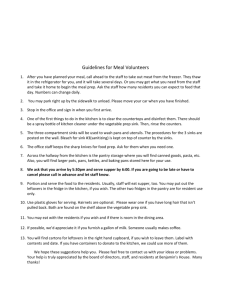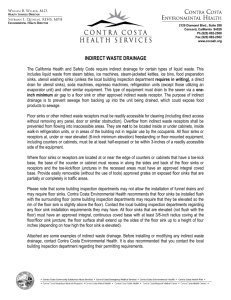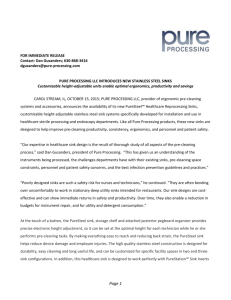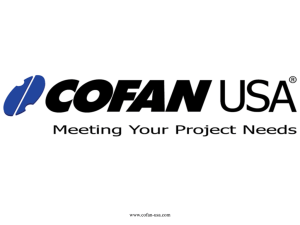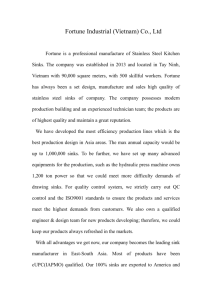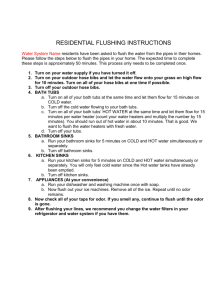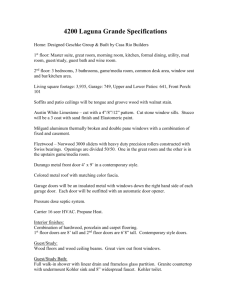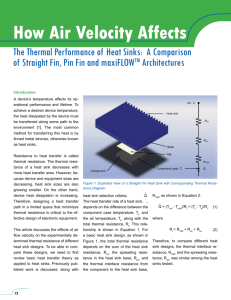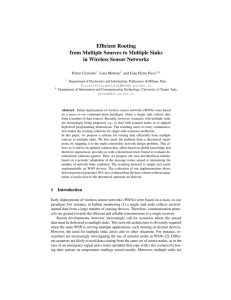Requirements for Environmental Health Notes
advertisement
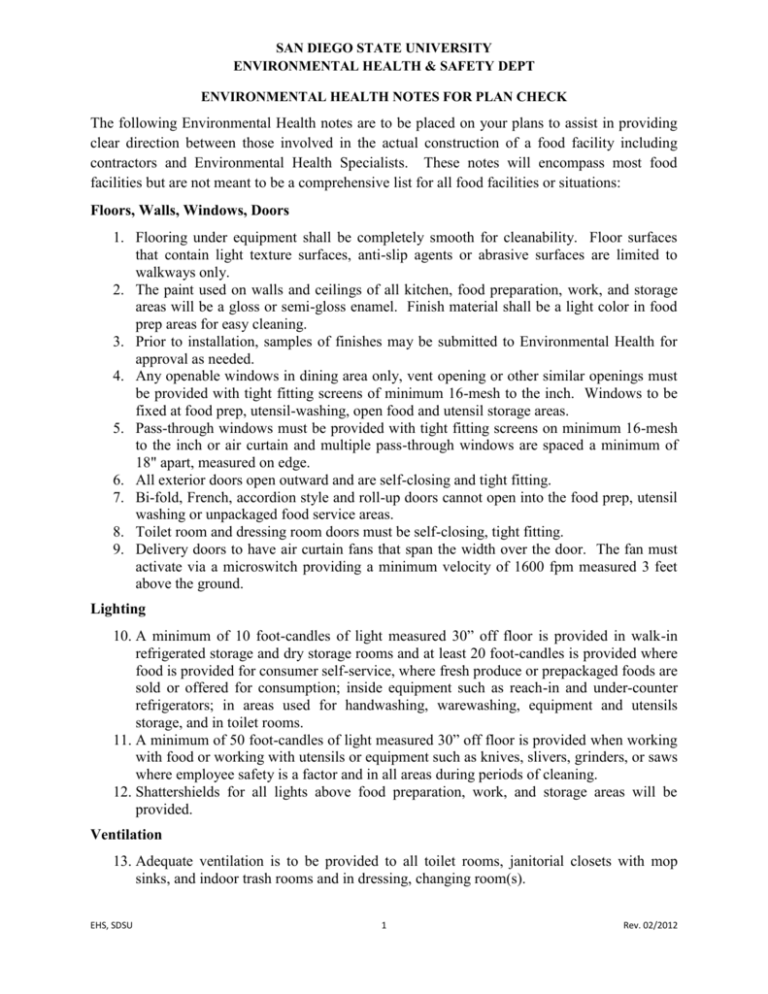
SAN DIEGO STATE UNIVERSITY ENVIRONMENTAL HEALTH & SAFETY DEPT ENVIRONMENTAL HEALTH NOTES FOR PLAN CHECK The following Environmental Health notes are to be placed on your plans to assist in providing clear direction between those involved in the actual construction of a food facility including contractors and Environmental Health Specialists. These notes will encompass most food facilities but are not meant to be a comprehensive list for all food facilities or situations: Floors, Walls, Windows, Doors 1. Flooring under equipment shall be completely smooth for cleanability. Floor surfaces that contain light texture surfaces, anti-slip agents or abrasive surfaces are limited to walkways only. 2. The paint used on walls and ceilings of all kitchen, food preparation, work, and storage areas will be a gloss or semi-gloss enamel. Finish material shall be a light color in food prep areas for easy cleaning. 3. Prior to installation, samples of finishes may be submitted to Environmental Health for approval as needed. 4. Any openable windows in dining area only, vent opening or other similar openings must be provided with tight fitting screens of minimum 16-mesh to the inch. Windows to be fixed at food prep, utensil-washing, open food and utensil storage areas. 5. Pass-through windows must be provided with tight fitting screens on minimum 16-mesh to the inch or air curtain and multiple pass-through windows are spaced a minimum of 18" apart, measured on edge. 6. All exterior doors open outward and are self-closing and tight fitting. 7. Bi-fold, French, accordion style and roll-up doors cannot open into the food prep, utensil washing or unpackaged food service areas. 8. Toilet room and dressing room doors must be self-closing, tight fitting. 9. Delivery doors to have air curtain fans that span the width over the door. The fan must activate via a microswitch providing a minimum velocity of 1600 fpm measured 3 feet above the ground. Lighting 10. A minimum of 10 foot-candles of light measured 30” off floor is provided in walk-in refrigerated storage and dry storage rooms and at least 20 foot-candles is provided where food is provided for consumer self-service, where fresh produce or prepackaged foods are sold or offered for consumption; inside equipment such as reach-in and under-counter refrigerators; in areas used for handwashing, warewashing, equipment and utensils storage, and in toilet rooms. 11. A minimum of 50 foot-candles of light measured 30” off floor is provided when working with food or working with utensils or equipment such as knives, slivers, grinders, or saws where employee safety is a factor and in all areas during periods of cleaning. 12. Shattershields for all lights above food preparation, work, and storage areas will be provided. Ventilation 13. Adequate ventilation is to be provided to all toilet rooms, janitorial closets with mop sinks, and indoor trash rooms and in dressing, changing room(s). EHS, SDSU 1 Rev. 02/2012 General Utilities 14. State on plans whether the facility is served by a municipal water system (if yes, indicate specific system, e.g. City of San Diego, Helix, Sweetwater, Padre Dam, etc.) or by well water. 15. State on plans whether the facility is served by a municipal sewer system (if yes, indicate specific system, e.g. City of San Diego, Escondido, etc.), or by a sub-surface sewage disposal system (i.e. septic tanks). 16. All plumbing, electrical and gas lines shall be concealed within the building structure to as great an extent as possible. All exposed conduits, plumbing, etc. shall be installed at least 6” off floor and ¾’ from wall using standoff brackets. 17. Conduits, plumbing or piping cannot be installed across any aisle way, traffic area or door opening. 18. Multiple runs or clusters of conduit or pipelines shall be furred down or encased in an approved sealed enclosure. 19. All seams, gaps, and openings to be properly sealed. Water Supply 20. The hot water heater will be a commercial type capable of constantly supplying hot water at a temperature of 120˚F to all sinks. In sizing the water heater, the peak hourly demand for all sinks, etc., are added together to determine the minimum required recovery rate. "Guidelines for Sizing Hot Water Heaters" available upon request. 21. Water supply to carbonators shall be protected by an approved reduced pressure principal backflow preventer. The relief valve shall drain indirectly to sewer with a legal air gap. Waste Water Disposal 22. All liquid waste shall be drained by means of indirect waste pipes into a floor sink. Floor sinks are to be installed flush with the finished floor surface and have suitable easily removable safety cover grates. 23. Floor drains shall be installed in floors that are water-flushed for cleaning and in areas where pressure spray methods for cleaning equipment are used, in restrooms, janitorial rooms, sculleries, and at bars with warewashing. Floor surfaces in areas pursuant to this shall be sloped 1:50 to the floor drains. 24. Floor sinks to be 50% exposed when no access is provided for cleaning or be in line with the front face of elevated freestanding equipment. 25. Approved backflow prevention devices shall be properly installed upstream of any potential hazard between the potable water supply and a source of contamination. Hoses shall not be attached to a faucet or hose bib unless an approved backflow preventer is provided. 26. No condensate or wastewater including HVAC will drain into the janitorial sink. 27. A separate wet waste dump fixture shall be provided for disposal of drink or waste ice or coffee waste. 28. Grease trap to be located outside the food service activity area, flush with the finished floor when indoors. Local wastewater district (City of San Diego Food Establishment Waste Division) to be contacted for grease removal requirements. Sinks 29. All warewashing sinks to have 3-compartments that are a minimum size of at least 18”x18”x12” deep (or 16”x20”x12” deep) with a minimum 18” drainboard at each end. If against a wall, it must have an 8” integral backsplash. However, it must be capable of EHS, SDSU 2 Rev. 02/2012 accommodating the largest utensil to be washed. A warewashing machine does not substitute for the sink requirement. 30. Sinks to have spout(s) capable of reaching each compartment. 31. Food prep sink compartment(s) to be at least 18”x18”x12” deep (or 16”x20”x12” deep) with a minimum 18” drainboard. Separate food prep sinks to be provided for meats and produce. 32. The 3 or 4 compartment bar sink to be at least 12”x12”x10” deep (or 10”x14”x10” deep) with a minimum 18” drainboard at each end. 33. Each handwashing sink must have permanently mounted single-service soap and paper towel dispensers. 34. All lavatories or hand sinks will have a combination faucet or premixing faucet capable of supplying water tempered to 100˚F. Self-closing or metered faucet to provide at least 15 seconds of water without reactivation. 35. For cleaning floor mats, the janitorial sink must be a minimum 24”x36” floor-mounted type. Mops shall be placed in a position that allows them to air-dry without soiling walls, equipment, or supplies. 36. The janitorial sink faucet will have a threaded outer lip for hose attachment and an approved backflow prevention device. No chemical dispensing systems or shutoff valves to be attached to mop sink faucet outlet (unless a “sidekick” plumbing device is installed). Trash Enclosure 37. A concrete slab is provided for trash, garbage, and grease container. If walls enclose area, the interior wall surfaces will be smooth, sealed and washable (e.g., plastered smooth and painted, etc.). Equipment 38. All food-related and utensil-related equipment shall meet or be equivalent to sanitation standards established by an American National Standards Institute (ANSI) accredited program. 39. All floor mounted equipment will be installed on minimum 6” sanitary legs, castors, or completely sealed in position on a 4” high curb with continuously coved base. Countertop equipment will be on 4” sanitary legs or sealed to the counter unless readily movable. 40. If soft drink, ice or other dispensers are self-service, or if refills are provided they must be push button types, or lever types where the lever contacts the container at least one inch below the rim. Cold Storage 41. Cold storage rooms shall be provided with a section of shelving installed to hold shallow cool down pans – not to exceed 4” in height. Space between shelving to be at least 8” high. 42. A thermometer shall be provided for each refrigeration unit. Dry Storage 43. Back-up dry storage shelving shall be a minimum of 96 linear feet (measured with tiers) or 25% of kitchen, food prep, and work areas, whichever is greater. Shelving shall be at least 18” deep and start a minimum of 6” off the floor surface. 44. Shelving over wet areas (sinks, mop sinks, etc.) and food prep surfaces will be metal. EHS, SDSU 3 Rev. 02/2012
